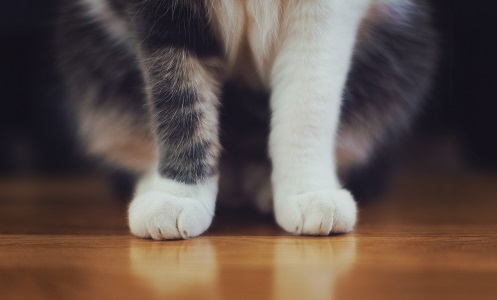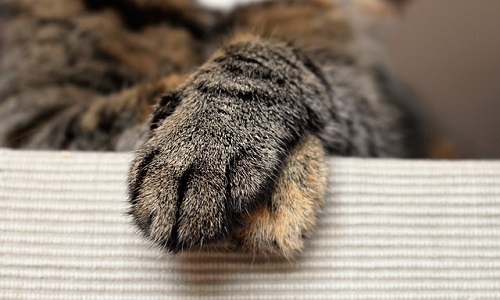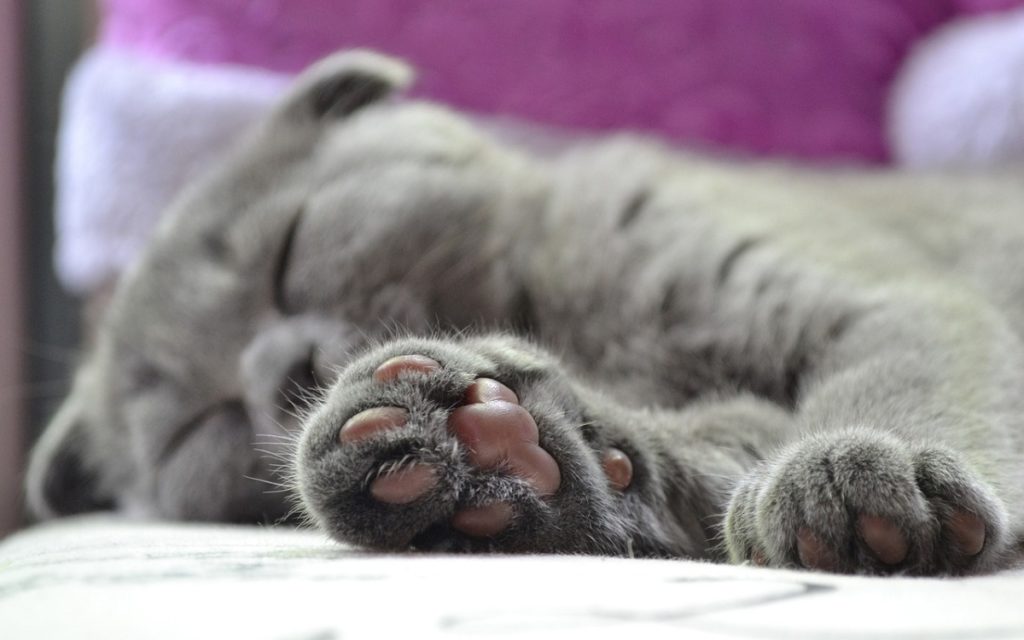Though a cat has paw pads that serve as a protective barrier, it doesn’t mean that they can’t have problems with their feet. Paw problems in cats include concerns like swelling, infection, and injury.
While thankfully it’s not something that happens very often, if you do notice your cat’s foot is swollen, it’s important to figure out the reason why. Don’t just ignore it and hope it goes away because in most cases it won’t.
Sometimes the reason your cat’s paw is swollen is simple and easily discerned. Maybe he’s received an insect bite or picked up a splinter somewhere. Burrs are also quite common, especially if you have an outdoor cat and live in an area where grass and woods are abundant.
Other times, you might find it’s a little more challenging to figure out why your cat’s paws are swollen. Unfortunately, even though cats might be known to have nine lives and always land on their feet, those little paws can suffer some real abuse. A cat uses their paws to explore, play, groom, climb, and a myriad of other activities, which makes them very vulnerable to trauma and other foot related issues.
Common Causes of Swollen Paws on Cats
Obviously, the most common culprits when it comes to cats with swollen paws is usually related to a cat’s environment. It could be the result of an insect bite, an allergic reaction, an injury, or an infection.
Injury and Trauma
Injury to a cat’s paw can come in the form of cuts and abrasions if they step on something sharp, or blisters from walking on a hot surface like pavement. A cat can also suffer injury from a foreign object that gets stuck in their paw pad or in between their toes, such as a splinter, a small nail, a tack, a shard of glass, or a burr.
Cats can even suffer from broken bones, including a broken toe. Most often a broken toe occurs when a cat snags their claw on something and then pulls it free using force. This can injure the toe and cause it to break or fracture, or in some cases become sprained.
There is no way to predict the type of hazards your cat may be exposed to in their daily explorations. Injury can happen just about any time or anywhere. Sometimes cats may even sustain an injury to their paw from their kindred.
This is because when cats play together, as a rule, they use both teeth and claws, making biting and scratching commonplace. This means they could suffer trauma from their playmates, or from other cats that aren’t as friendly initiating a fight. Or they could get bitten by a squirrel or small rodent they’ve found to play with. The possibilities are endless!
Another thing to keep in mind is that most cats are jumpers and climbers. This means that fractures, sprains, and dislocations are quite common. Not to mention, cats love to wind themselves around their human’s legs and get beneath their feet, especially when they’re hungry or want attention.
This makes them a prime candidate for having one of those little paws stepped on by accident. Also, for some reason, outdoor cats love to lay beneath cars and play in the wheel wells. This can be dangerous. They could accidentally get a paw crushed beneath a tire because they didn’t move fast enough to get out from underneath it once it began moving.
Allergic Reactions
Cat’s aren’t immune to allergens, either. You might think they are often the cause of feline allergies, and that is sometimes true for us humans. But cats can suffer from feline allergies over their own, too.
 Allergies can affect a cat in different ways, including swollen paws, itching, runny eyes and nose, feline digestive issues, and more. Allergies can be a reaction to something in their environment, or sometimes to something in the carpeting or in the grass in you or your neighbor’s yard.
Allergies can affect a cat in different ways, including swollen paws, itching, runny eyes and nose, feline digestive issues, and more. Allergies can be a reaction to something in their environment, or sometimes to something in the carpeting or in the grass in you or your neighbor’s yard.
Sometimes reactions occur because of feline food allergies, and sometimes they may be a reaction to a bug bite or a bee sting. Regardless of the cause, any type of allergic reaction can prompt your cat to chew, bite, and lick at his paws, especially if they are itchy.
Excessive licking will trigger swelling and cause further inflammation in cats. It can even progress to scabbing and hair loss, making the whole situation even worse. In some cases, such as bee stings, a cat could go into anaphylactic shock, a life-threatening allergic reaction that depends on a fast response. That is one of the reasons it’s important not to ignore it if you notice one of your cat’s paws looks swollen, especially if you suspect they have been stung or bitten by something.
Complications from Ingrown Toenails and Declawing
Occasionally a cat’s paw (or paws) will be swollen due to ingrown claws that grow and curl into your cat’s paw pad. It pierces the tender skin of the pad, causing feline pain, inflammation, and in many cases, infection. Though this problem is more prevalent in senior cats, it can happen with any feline of any age if you don’t keep an eye on their claws and trim them when needed.
Usually, if they have scratching posts, a cat’s claws stay at a healthy length. But sometimes there may be an underlying health condition that is causing their nail overgrowth. It’s best to see your vet if this happens frequently to rule out anything more serious.
In other cases, if you’ve recently had your cat declawed, they could suffer from complications related to the declawing procedure. Having a cat declawed causes severe trauma to their feet and can be a significant source of pain, swelling, and general misery for your kitty.
Abscesses
Some cats may develop abscesses that can affect their feet. These abscesses may feel like a round, warm, firm, lump beneath the skin, making your cat’s paw appear swollen. Because the abscess is full of infection, it will release a nasty smelling discharge when it finally bursts open. Try not to let your cat lick an abscess. It will only make the infection worse and possibly cause it to spread.
Tylenol Toxicity
Sometimes, your pet can experience swelling of the feet as a side effect of cat poisoning, especially with drugs like Tylenol (sometimes called paracetamol). Fluid can build up in their feet when they have ingested toxic levels of this drug. You should see your vet right away if you suspect your cat is poisoned because they may need supportive care therapy like fluids and oxygen, among other treatment measures.
Pododermatitis
Another common cause of swelling in a cat’s paws is a health condition called pododermatitis. This disorder is also known as pillow foot or pillow paw. Swelling is confined to the paw pad, giving it a soft, pillowy appearance.
If the condition is mild, it may not bother your cat too much. However, as the condition progresses, it can cause your cat’s paw to swell even more, appear to be bruised, and develop painful sores. The paw pad eventually may split, creating painful ulcers which will require treatment to avoid infection.
Pillow paw is essentially a condition of severe inflammation that attacks your cat’s footpad. Very rarely will only one footpad be affected. In most cases, they will all be inflamed. It’s thought that pillow paw is a result of a cat’s immune system mistakenly producing a surplus of lymphocytes.
These lymphocytes collect in the pad of your cat’s paw. This collection of lymphocytes then triggers an attack of antibodies to perfectly healthy paws, creating swelling and pain.
Signs and Symptoms of Swollen Cat Paws
Obviously, swelling is itself a symptom of something. However, cats can experience other signs as well, depending on the root cause of their swollen paws.
If your cat is suffering from pododermatitis, in addition to their mushy, pillowy footpad, they can also experience symptoms like:
- Lethargy
- Bruised appearance of the footpad
- Ulcerations and splitting of the pad
- Bleeding from their paws
- Excessive licking of their feet
- Tenderness and pain when you touch their paw
- Limping and lameness
- Loss of appetite leading to anorexia
If your cat’s foot is swollen because of something else, such as a trauma or injury, you might notice that swelling is only in one foot instead of all of them. Your cat’s foot may look red and inflamed and may feel warm when you touch it. You might notice discharge, blisters, pus-filled abscesses, or sores that leak and drain. They may limp or favor the injured foot.
In other cases, you may notice your cat grooming his paws seemingly compulsively. If your cat has a swollen paw because of an ingrown claw, you may be able to see the claw growing into the skin, with redness and infection evident at the wound site.
Of course, there are other underlying health conditions that can also cause a cat’s paws to swell, including autoimmune disorders and feline skin cancer that attacks the toes and feet.
Treating swollen paws effectively will depend on what’s causing the problem in the first place. For cats with underlying health conditions such as autoimmune disorders or pillow foot, they will definitely require medications and treatment under a vet’s supervision. A cat could even need supportive care if they suffer from a severe flare-up of an autoimmune disorder.
Treatment and Recovery of Swollen Paws in Cats
Your cat’s treatment and recovery will really depend on the reason his paw was swollen in the first place. Injuries and traumas can take a few days to heal, sometimes longer. If your cat has suffered injury or trauma, it’s important to keep them off the injured foot or feet as much as you possibly can.
 That may mean you need to crate him for a couple of days, so he can’t roam too much, and you may need to change the type of kitty litter you use, at least temporarily. Choose one that will help you keep down contamination and avoid further infection.
That may mean you need to crate him for a couple of days, so he can’t roam too much, and you may need to change the type of kitty litter you use, at least temporarily. Choose one that will help you keep down contamination and avoid further infection.
If your cat has suffered a broken or fractured bone, your vet may decide to splint the injured digit or limb. This can definitely make things interesting for your cat. They don’t care for splints and casts too much.
If you opt to not keep him crated during his recuperation period, you should still make every effort to keep him away from anything that could cause additional problems for his health and feet. Keep him off of hot pavement, keep him away from yards that are heavily fertilized, don’t treat your floors or carpeting until their paws are completely healed, and if necessary, use an antiseptic to soak his feet as instructed by your vet.
Additionally, should your cat have some kind of allergy or underlying health concern that is causing his paws to swell, or if he has developed a secondary infection, you should make sure you are giving him all the necessary medications he has been prescribed.
Continue his meds even if your cat seems as though he is doing better, and his symptoms have improved. If your cat isn’t given his full round of medications, he could experience a resurgence in symptoms and it could be even worse than the first time. This means more swelling and pain for your furry little feline and more downtime and trying to keep him contained and off his paws.
Ideally, you should follow your vets’ instructions and stick to the designated treatment plan to the letter. When you do, barring underlying health conditions that resist treatment, there is no reason your cat shouldn’t fully recover and be back to his curious, playful selves in no time.
Citations:
“Pododermatitis in Cats – Symptoms, Causes, Diagnosis, Treatment, Recovery, Management, Cost.” Wag!, 28 Dec. 2016, Accessed 9 Dec 2018. www.wagwalking.com/cat/condition/pododermatitis.
“Swollen Paws in Cats.” PetMD, Accessed 9 Dec 2018. www.petmd.com/cat/emergency/accidents-injuries/e_ct_swollen_paws.
“Paw Inflammation in Cats – Symptoms, Causes, Diagnosis, Treatment, Recovery, Management, Cost.” Wag!, 15 Oct. 2016, Accessed 9 Dec 2018. www.wagwalking.com/cat/condition/paw-inflammation.
McQuerrey, Lisa. “How to Treat a Cat With a Swollen Paw.” Cuteness, 9 Feb. 2017, Accessed 9 Dec 2018. www.cuteness.com/article/treat-cat-swollen-paw.




